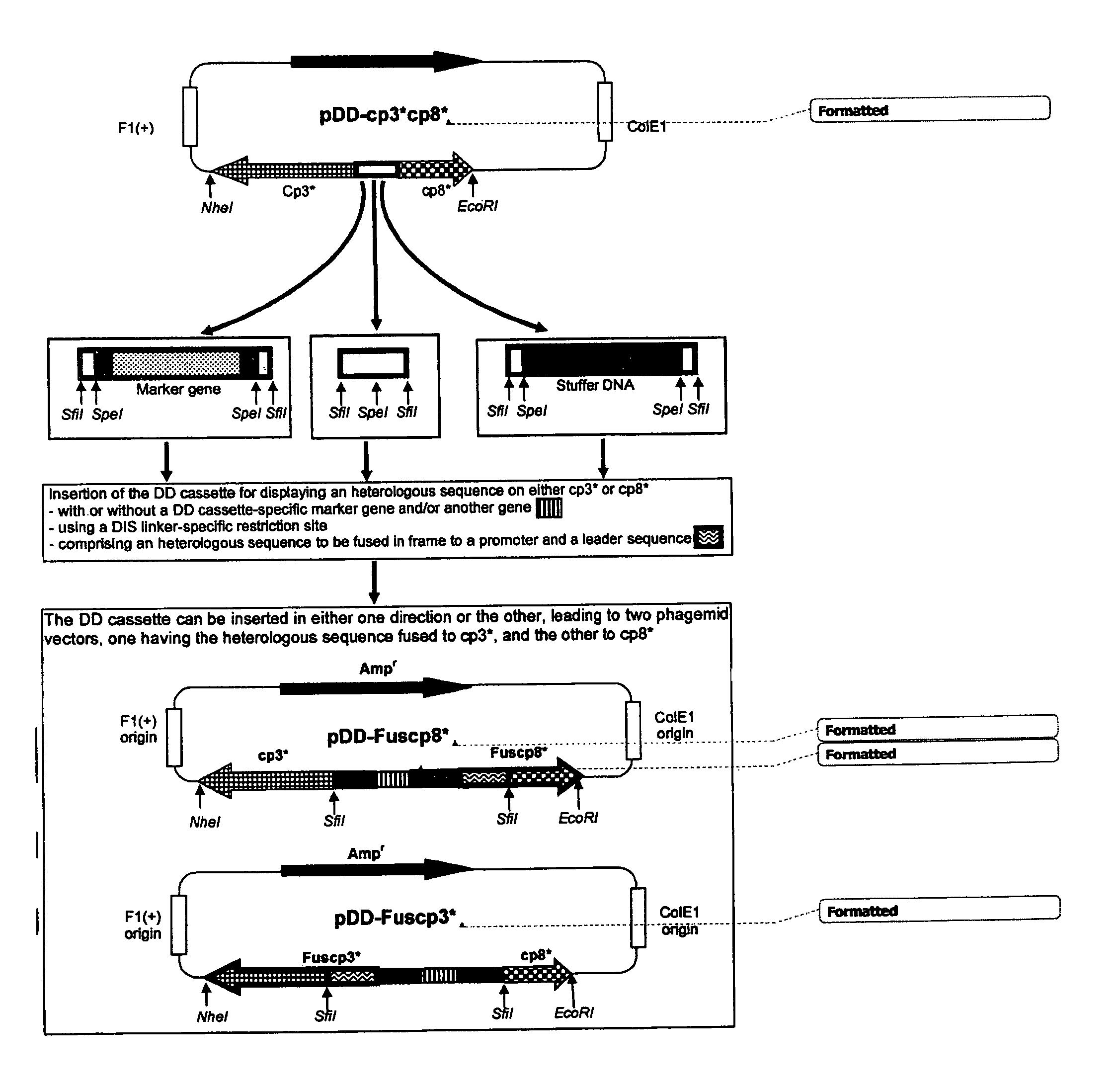Phage display technologies
a technology of phages and coat proteins, applied in the field of improved phagemid vectors, can solve the problems of large size and cloning strategy limitations of heterologous sequences, affecting the efficiency of the system, and affecting the choice of coat proteins for display
- Summary
- Abstract
- Description
- Claims
- Application Information
AI Technical Summary
Benefits of technology
Problems solved by technology
Method used
Image
Examples
example 1
Preparation and Expression of a DIS Linker2-Modified DNA Sequence Encoding a Filamentous Phage Coat Protein 3 (cp3*) for Displaying Proteins and Peptides
[0152]a) Materials & Methods
[0153]Production of M13 Helper Double-Stranded DNA.
[0154]A commercially available bacteriophage M13 helper (VCSM13, Stratagene, La Jolla, Calif.) was used as a source for isolating its double-stranded replicative form DNA. Into 2 ml of LB medium, 50 μl of a culture of a bacterial strain carrying an F′ episome (E. Coli XL1 Blue, Stratagene, La Jolla, Calif.) was admixed with 1×1011 bacteriophage particles. The admixture was incubated for 4 to 5 hours at 37° C. with constant agitation. The admixture was then centrifuged at 12,000×g for 5 minutes to pellet the infected bacteria. After the supernatant was removed, the bacteria pellet was used in a standard DNA extraction protocol using Qiagen mini prep kit and analysed in 1% agarose gel electrophoresis.
[0155]Production of a Gene Encoding a DIS Linker2 N-Termi...
example 2
Preparation and Expression of a DIS Linker2-Modified DNA Sequence Encoding a Filamentous Phage Coat Protein 8 (cp8*) for Displaying Proteins and Peptides
[0176]a) Materials & Methods
[0177]Production of a Gene Encoding a DIS Linker2 N-Terminal Modified cp8 Protein (cp8* Protein), Related Vectors Expressing cp8*-Based Fusion Proteins, and their Analysis
[0178]The production of cp8* starting from a commercially available bacteriophage M13 helper and the cloning strategy are identical to those indicated in Example 1 for cp3*. The PCR was carried out using the primers cp8*FW and cp8*RW (SEQ ID NO.: 15 and SEQ ID NO.: 16; Table I). The PCR conditions used were: 95° C. for 2 min (1 cycle); 95° C. for 20 sec, 63° C. for 30 sec, 72° C. for 40 sec (35 cycles). The PCR amplification was carried out using Expand High Fidelity (Roche) according to the manual instructions. The DNA template (obtained from VCSM13) and the primers concentration used were the same described for the cp3* PCR amplificati...
example 3
Functional Validation of Phage Displaying Cp3* or Cp8* Fused to a Peptide or an Antibody
[0186]a) Materials & Methods
[0187]Amplification of the Phagemids
[0188]The following methods were performed as described in the literature (“Molecular Cloning: A Laboratory Manual”, Sambrook et al., Cold Spring Harbor Press, NY, 1989). Electrocompetent E. coli XL1-Blue cells were electroporated (0.2 cm E. coli Pulser cuvette, 2.5 Kv) with 50 ng of the phagemid vector (pRIB1-cp3, pRIB-HAcp3, pRIB-e44 cp3, pRIB1-cp3*, pRIB1-HAcp3*, pRIB1-e44 cp3*, pRIB2-cp8*, pRIB2-HAcp8*, or pRIB2-e44 cp8*).
[0189]Each cuvette was flushed immediately with 1 ml and then with 2 ml of SOC medium (Sodium chloride 0.5 g / L, Tryptone 20.0 g / L, Yeast extract 5.0 g / L, KCl 2.5 mMol, pH adjusted to 7.0 with NaOH: after autoclaving, 5 ml of a 2 M MgCl2 sterile solution and 20 ml of a 1 M sterile glucose solution for 1 liter of medium are added just before use) at room temperature. The 3 ml culture was transferred into a 50 ml p...
PUM
| Property | Measurement | Unit |
|---|---|---|
| temperature | aaaaa | aaaaa |
| concentration | aaaaa | aaaaa |
| concentration | aaaaa | aaaaa |
Abstract
Description
Claims
Application Information
 Login to View More
Login to View More - R&D
- Intellectual Property
- Life Sciences
- Materials
- Tech Scout
- Unparalleled Data Quality
- Higher Quality Content
- 60% Fewer Hallucinations
Browse by: Latest US Patents, China's latest patents, Technical Efficacy Thesaurus, Application Domain, Technology Topic, Popular Technical Reports.
© 2025 PatSnap. All rights reserved.Legal|Privacy policy|Modern Slavery Act Transparency Statement|Sitemap|About US| Contact US: help@patsnap.com



